Our first year of website growth was slow. During the second year, our growth improved, but we weren’t seeing the results we wanted. The total monthly views for our blog hovered around 15k–20k, and we seemed to be stuck on a plateau.

We were following inbound practices and blogging regularly, but our average monthly growth rate was a mere 5%. Why was our growth not, well, growing?
Then, out of nowhere came Pamela Vaughan’s blogging tactic: historical optimization. Was this the key to defeating our traffic plateau?
In short, yes, this was our key. We increased our number of monthly organic search views by 304% in 2015. In 2016, we again increased our monthly organic search views by nearly 100%.
Overall, since starting to use Hubspot in 2014, we have increased our traffic by over 5,635%.
Here’s how it worked for our business — we're about to share all the details with you.
- We determined if historical optimization should be our focus
- We prioritized which posts to work on first
- We optimized those posts
- We repeated steps two and three
- We practiced the art of patience
Step 1: Should historical optimization be our focus?
In her article on the HubSpot marketing blog, Pamela outlines how she discovered that 76% of HubSpot’s monthly blog views came from “old posts.” Gulp. Was this us, too?
Using HubSpot attribution reports combined with Excel, we determined that over 53% of our organic blog traffic was coming from just 12 blog posts. The other 47% came from the remaining 541 posts.
This had huge implications for us.
We were spending all our time pushing out new content week after week. On average, we were publishing 3–4 new blog posts each week. Some weeks, we posted eight. But it seemed those posts weren't even bringing in the bulk of our views! It was our older posts — those top 12 older posts — that were bringing in the bulk of our traffic.
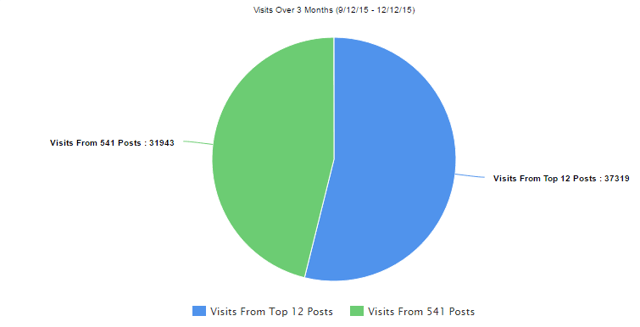
After reaching out to our HubSpot CSM and discussing our ideas with her, she affirmed our decision to focus less on creating new content and more on optimizing our older content.
Note: We did not entirely stop creating new content. We still published new posts on a regular basis, but it was closer to one new post per week.
Step 2: Prioritize which posts to work on first.
After deciding historical optimization was what we should focus on, the next step was to choose where to start. The first posts we optimized were the 12 posts that generated the most traffic for us already. But beyond that, we were unsure which ones to work on next. With over 550 posts in our content library, there were many different routes we could have chosen to take.
The route we decided to take was this one: Optimize the posts that brought in the most leads. How did we know which posts brought in the most leads? By using HubSpot attribution reporting. This gave us approximately 40 posts to work on optimizing next.
Step 3: Optimize those posts.
Our primary purpose — besides defeating our traffic plateau — was to continue to provide helpful, useful, and relevant information to our visitors. Our optimization strategy consisted of more than just adding relevant keywords. We used the HubSpot blogging tool to update every post for accuracy, freshness, and comprehensiveness.
The elements we added or altered on our posts:
- The title — All of our top posts answered questions. Most of our tops post were “How to” posts like “How to Get a Car Dealer License,” or “How to Get a Bonded Title.” Restructuring the titles of blog post to mimic our top-performing posts was our first course of action. We wanted to offer a solution to the reader and show them that by reading our post they would be able to accomplish a task.
- The copy — Since we were changing the titles, our copy had to change, too. How could we make the copy of the blog posts more informative? More relevant? Answer more questions? Get found in search engines better or faster? There is a ton of information out there on how to do keyword research and keyword optimization. For us, we have always asked ourselves this question after we finished optimizing: “If I were reading this, what else would I want to know? What questions would I still have that weren't answered?” If we couldn’t think of any questions, we moved on. If we could, we went back and further optimized.
- The internal links — Have you ever been lost in a Wikipedia hole? Clicking around to different articles? That’s what we wanted to create for our readers. We had over 550 blog posts at our time of optimization, but we weren’t linking to posts within each other. We worked to create a web of articles that readers could click through, and we tried to leverage our top-viewed posts to generate visits to lower-viewed posts.
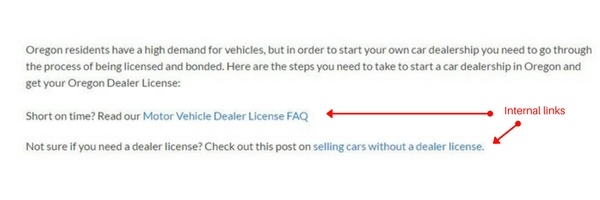
- The external links — If we couldn’t provide information by linking to our own internal post, we linked to an external post on a different website. We did this to make our blog and website a more valuable and scalable resource for others.
- The images — To be honest, images are not our strong point. But we did update our posts to include relevant images, not just images to break up our text. If an image was being used only as a text break, we eliminated it in choice of a faster page load time.
The additional steps we took:
- Changing the publish date — At first we forgot to do this! We just clicked “update” and never thought about changing the publish date. But changing the publish date is important. It shows your readers (and Google) your post is fresh.
- Updating the CTA with relative copy — Why just update the post's copy when you can also update the CTA's copy? Readers want to connect with what you're saying. We updated all our CTAs with relevant keywords instead of leaving them vague and generic.
Step 4: Repeat steps two and three.
Repeat, repeat, repeat.
At this point, we didn’t know if our optimization was working. We did have a hunch, though, so we kept on with our journey and continued optimizing down the list of posts.
Step 5: Practice the art of patience.
After patiently waiting for the views to flood in, here are the results we ended with.
Before optimizing, we were averaging 5% of organic traffic growth month after month for nearly an entire year. Talk about a major traffic plateau.
One month after optimizing, we saw a 40% increase in monthly organic traffic. The month after that, we saw another 25% increase. The month after that, another 21%. We had officially broken our traffic plateau! For us, historical optimization was the gift that kept on giving.
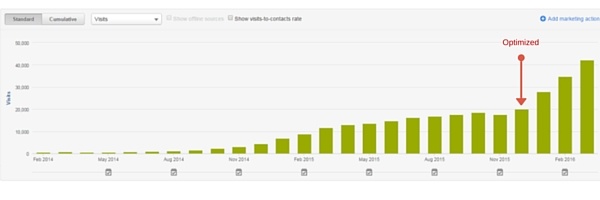
The chart below shows 10 posts we optimized. The average increase in views during the first month after optimization was 20%. The average increase in growth we saw three months after optimization was 82%.
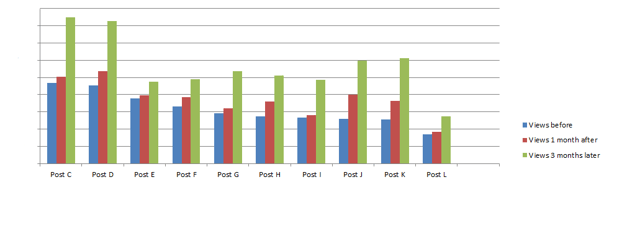
We are on social media, but we didn't share our optimized posts to our social channels every time we updated. The growth you see is purely from the work we put in and the updates we implemented.
This is our traffic today, 14 months after starting this historical optimization journey.
We’ll say it again: Historical optimization is the gift that keeps on giving. We’ve gone from 25,000 views a month to nearly 100,000 views a month.
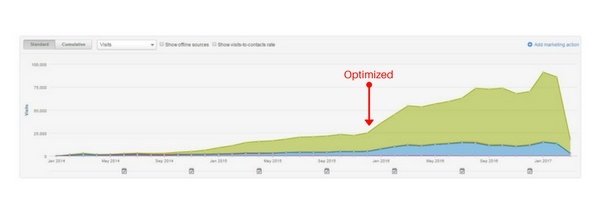
Here at Surety Solutions, we're a small company with a marketing team of only two people. We found we did not need a giant marketing team to reap the benefits of historical optimization.
This process also made it apparent that we didn't need a blog that had been around for 10 years. We had been using HubSpot for just under two years when we started this journey of historical optimization. And look where we are now.
Today, historical optimization is a major part of our marketing strategy. Optimizing the past has allowed us to put less pressure on ourselves for our new content. We don’t have new content that goes viral. But we now know after we publish new content it will soon need to be optimized. And that's what we've found is the best way for us to generate big traffic gains month after month. That's how our business will continue to grow.




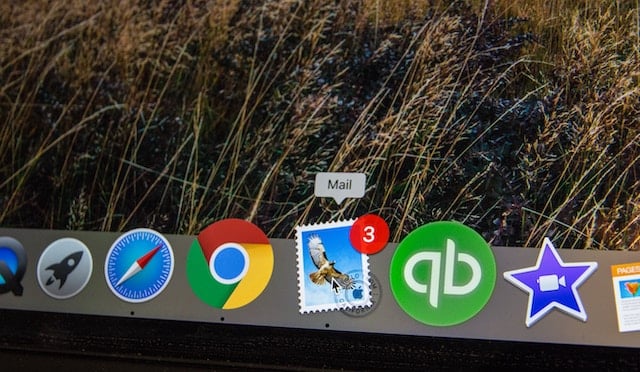

![Plannuh Builds Product With the Customer at the Forefront [Customer Story]](https://blog.hubspot.com/hubfs/IMG_0128-3.jpg)
![How One HubSpot Customer Uses Pop-Up Forms and Workflows to More Intelligently Help Customers [Customer Story]](https://blog.hubspot.com/hubfs/inbound-lorax-ff7a59-light.jpg)


![How TurboTenant Makes Property Management Easy With HubSpot [Customer Story]](https://blog.hubspot.com/hubfs/unique-balcony-architecture.jpg)